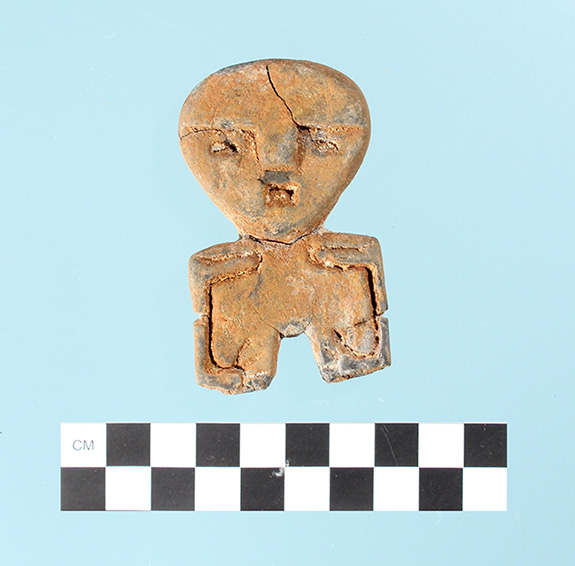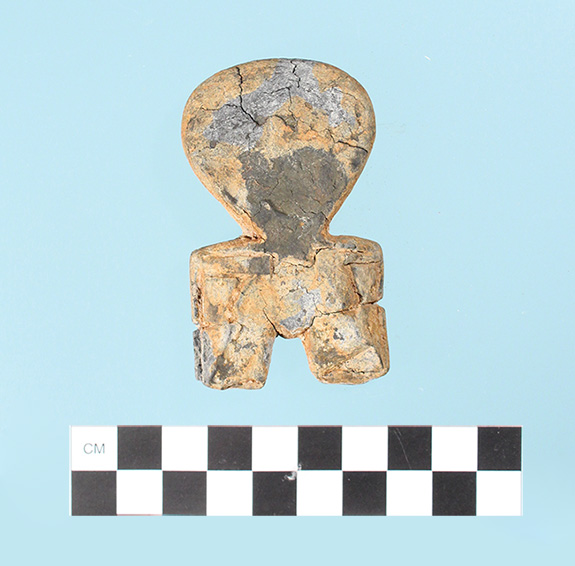John H. House (Arkansas Archaeological Survey, ARAS-UAPB Research Station)
Artifact of the Month - August 2018
In August 1978, Bill Parker of Pine Bluff found a small stone figurine during construction at a paper mill near that city. Mr. Parker brought the artifact to then UAPB Station Archeologist, Leslie C. Stewart Abernathy. Stewart-Abernathy visited the location to observe the context of the find and to make a collection that included 52 lithic flakes, 89 percent novaculite by weight, and 1 small grog-tempered pottery sherd. Mr. Parker generously donated the figurine to the Arkansas Archeological Survey.
The find location is on the edge of the West Gulf Coastal Plain uplands (sometimes referred to as “the piney woods”), overlooking a small bayou where it leaves the uplands and enters the Arkansas River floodplain.

The Parker figurine is 72mm in length with a maximum width of 42mm and average thickness of about 11mm. It has a rectangular cross section. The object is made of a dark grey shale or slate with a reddish-brown patina on its surface from weathering.
We initially conjectured that the artifact was associated with the Poverty Point culture. The Poverty Point culture flourished in portions of the Lower Mississippi Valley and adjacent Gulf Coast between about 2000 and 700 BC and is characterized by large-scale mound building, long distance exchange in raw materials, and distinctive artifacts such as fired clay balls and rare ceramic human figurines. The low frequency of pottery at the find location and the preponderance of novaculite in the chipped stone materials are consistent with Poverty Point and contemporary cultures.
The Poverty Point site, near Epps, Louisiana, was by far the largest Archaic period ceremonial center constructed in the Southeast. According to archeologist Jon Gibson, a vast trade network emanating from Poverty Point drew the participation of dozens of communities in the central and lower Mississippi Valley. Several contemporaneous communities located in southeast Arkansas and in the southern Ouachita Mountains participated in the Poverty Point cultural sphere. This trade generated a widespread distribution of artifacts made from a variety of imported materials, including shell, copper, and varieties of stone brought from considerable distances. These materials were used to make carved beads and figurines depicting humans, insects, animals, and birds. These objects represent an expansion in the use of artworks to symbolize relationships between human and nonhuman beings.
In 1982, replying to a letter from then Toltec Station Archeologist Martha Rolingson, Dr. Clarence Webb (1902–1999) supported a Poverty Point association for the Parker figurine. Dr. Webb cited illustrations from his 1977 Geoscience and Man monograph on Poverty Point culture, pointing to distinctive features shared by the Jefferson County figurine and artifacts from Poverty Point culture contexts. These include rectangular eyes and mouths occurring on baked clay figurine fragments from the Poverty Point site in Louisiana and the pattern of incising on a tablet made of jasper, a silicate rock similar to chert, from Jaketown, a prominent Poverty Point culture site in Mississippi. Webb, a medical doctor from Shreveport, conducted and published research at prehistoric sites in Louisiana and neighboring states for over five decades.
The figurine, now in the research collections of the ARAS-UAPB station, remains intact 40 years after its discovery, though it has developed cracks and in places exhibits a residue that may be from salt or other soluble minerals that have made their way to the surface of the piece as it dried.


Artifact of the Month Series
A first principle of archeology is that the significance of artifacts depends upon documented information about the context of their discovery. At what site was the artifact found? Can we figure out the age of the artifact? Where was it found in relation to site features (houses, trash deposits, activity areas, etc.) and the distribution of other artifacts? Only with knowledge of those facts can we assess further information about the manufacture and use of artifacts, and their role in other spheres of activity such as social organization, trade and exchange, and religious practice.
In this series, we feature select artifacts that are extraordinary both for the context of their discovery and for their unique qualities that contribute exceptionally important information about Arkansas culture and history. New artifacts will be added monthly throughout 2018. Find the list of artifacts here.
 Collections and items in our institution have incomplete, inaccurate, and/or missing attribution. We are using this notice to clearly identify this material so that it can be updated, or corrected by communities of origin. Our institution is committed to collaboration and partnerships to address this problem of incorrect or missing attribution. For more information, visit localcontexts.org.
Collections and items in our institution have incomplete, inaccurate, and/or missing attribution. We are using this notice to clearly identify this material so that it can be updated, or corrected by communities of origin. Our institution is committed to collaboration and partnerships to address this problem of incorrect or missing attribution. For more information, visit localcontexts.org.
 The Arkansas Archeological Survey is committed to the development of new modes of collaboration, engagement, and partnership with Indigenous peoples for the care and stewardship of past and future heritage collections.
The Arkansas Archeological Survey is committed to the development of new modes of collaboration, engagement, and partnership with Indigenous peoples for the care and stewardship of past and future heritage collections.
 The TK Notice is a visible notification that there are accompanying cultural rights and responsibilities that need further attention for any future sharing and use of this material. The TK Notice may indicate that TK Labels are in development and their implementation is being negotiated. For more information about the TK Notice, visit localcontexts.org.
The TK Notice is a visible notification that there are accompanying cultural rights and responsibilities that need further attention for any future sharing and use of this material. The TK Notice may indicate that TK Labels are in development and their implementation is being negotiated. For more information about the TK Notice, visit localcontexts.org.
